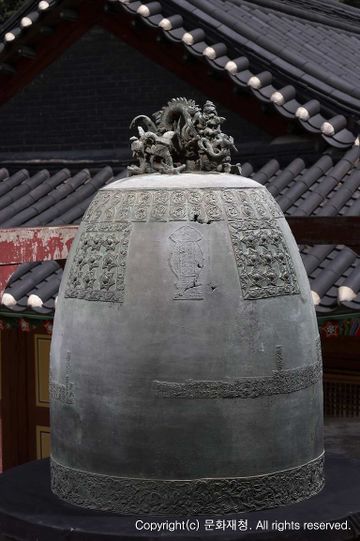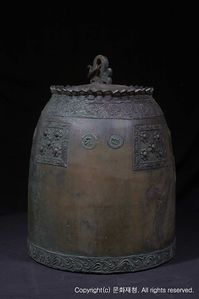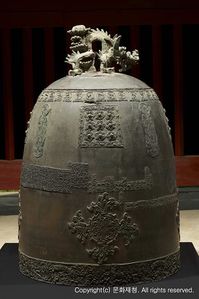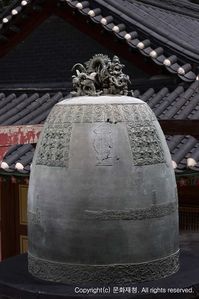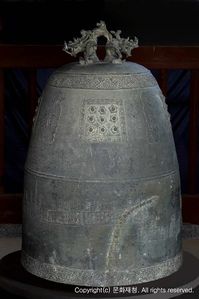"사인비구 제작 동종 - 서울 화계사 동종"의 두 판 사이의 차이
(→영문) |
(→영문) |
||
| 34번째 줄: | 34번째 줄: | ||
In Buddhist temples, large bronze bells are used to gather people for rituals and to announce time. | In Buddhist temples, large bronze bells are used to gather people for rituals and to announce time. | ||
| − | This bell was made in 1663 by Monk Sain and | + | This bell was made in 1663 by Monk Sain and five other artisan-monks. Monk Sain was a bell master who worked between the late 17th and early 18th centuries during the Joseon period (1392-1910). Eight of his works are designated as Treasure No. 11. |
| − | The cannon at the top of this bell, by which it is hung, has a dragon-shaped decoration. Unlike most Korean bells which have their cannon consisting of a sound tube and a single dragon decoration, the cannon of this bell features a pair of dragons but no sound tube. The | + | The cannon at the top of this bell, by which it is hung, has a dragon-shaped decoration. Unlike most Korean bells which have their cannon consisting of a sound tube and a single dragon decoration, the cannon of this bell features a pair of dragons but no sound tube. The bell is ornately decorated with Sanskrit letters at the top and flower and scroll designs at the bottom. On the body of the bell is an inscription wishing for the prosperity of the royal court and the spread of the Buddha’s teachings. Another record on the bell states that Monk Sain '''(? Or was it some other monk?)''' was bestowed an honorary government post. |
| − | This bell | + | This bell shows a well-balanced structure while maintaining a realistic and exquisite design which makes it a masterpiece among large bronze bells in Korea. It is also valuable as a historical source about the society of that period. |
===영문 해설 내용=== | ===영문 해설 내용=== | ||
2020년 10월 19일 (월) 08:10 판
| 사인비구 제작 동종 - 서울 화계사 동종 Bronze Bell Cast by Buddhist Monk Sain - Hwagyesa Temple, Seoul |
|
| 대표명칭 | 사인비구 제작 동종 - 서울 화계사 동종 |
|---|---|
| 영문명칭 | Bronze Bell Cast by Buddhist Monk Sain - Hwagyesa Temple, Seoul |
| 한자 | 思印比丘 製作 銅鍾 - 서울 華溪寺 銅鍾 |
| 주소 | 서울특별시 강북구 화계사길 117 |
| 지정번호 | 보물 제11-5호 |
| 지정일 | 2000년 2월 15일 |
| 분류 | 유물/불교공예/의식법구/의식법구 |
| 시대 | 조선시대 |
| 수량/면적 | 1구 |
| 웹사이트 | 사인비구 제작 동종 - 서울 화계사 동종, 국가문화유산포털, 문화재청. |
|
|
|
해설문
국문
서울 화계사 동종은 조선 시대의 승려 사인(思印)이 보조 장인 5명과 함께 숙종 9년(1683)에 만든 범종이다. 원래 영주 희방사에 있었는데 고종 35년(1898)에 화계사로 옮겨졌다. 범종은 절에서 시각을 알리거나 의식을 행할 때 사용한다. 장엄하게 울리는 소리는 종교적인 분위기를 극대화하며, 종소리를 듣는 사람은 자신의 악업(惡業)을 깊이 뉘우치고 마침내 깨달음을 얻도록 인도한다는 의미가 있다. 또한 종소리가 울려 퍼지듯 부처님의 가르침을 널리 펼친다는 뜻도 담겨 있다.
종의 꼭대기에는 두 마리 용의 머리가 서로 연결되어 있는데, 이는 종을 매는 고리인 용뉴(龍鈕) 역할을 한다. 보통 범종의 용뉴는 한 마리 용으로 된 장식과 음통으로 구성되어 있는 것과 달리 이 종은 음통이 없고 쌍룡으로만 장식된 것이 특징이다. 몸통의 윗부분은 범자문으로 장식되어 있고, 아랫부분은 보상화문과 당초문으로 화려하게 장식되어 있다. 또한 몸통에는 왕실의 안녕과 불법(佛法)이 전파되길 기원하는 내용이 적혀 있으며, 승려가 공명첩을 얻었다는 사실 또한 기록되어 있다.
서울 화계사 동종은 구성이 안정적이고, 표현이 사실적이며 화사하여 조선 시대 범종의 수작으로 꼽힌다. 또한 당시의 사회상도 알 수 있어 역사적 자료로서도 가치가 높다.
영문
Bronze Bell Cast by Buddhist Monk Sain - Hwagyesa Temple, Seoul
In Buddhist temples, large bronze bells are used to gather people for rituals and to announce time.
This bell was made in 1663 by Monk Sain and five other artisan-monks. Monk Sain was a bell master who worked between the late 17th and early 18th centuries during the Joseon period (1392-1910). Eight of his works are designated as Treasure No. 11.
The cannon at the top of this bell, by which it is hung, has a dragon-shaped decoration. Unlike most Korean bells which have their cannon consisting of a sound tube and a single dragon decoration, the cannon of this bell features a pair of dragons but no sound tube. The bell is ornately decorated with Sanskrit letters at the top and flower and scroll designs at the bottom. On the body of the bell is an inscription wishing for the prosperity of the royal court and the spread of the Buddha’s teachings. Another record on the bell states that Monk Sain (? Or was it some other monk?) was bestowed an honorary government post.
This bell shows a well-balanced structure while maintaining a realistic and exquisite design which makes it a masterpiece among large bronze bells in Korea. It is also valuable as a historical source about the society of that period.
영문 해설 내용
불교 사찰에서 범종은 의식을 행할 때 사람들을 모으거나 시각을 알릴 때 사용한다.
이 동종은 승려 사인이 1683년에 보조 장인 5명과 함께 만들었다. 사인은 17세기 중반부터 18세기 초반까지 활동한 주종장(鑄鍾匠)으로, 그가 남긴 작품 중 8개의 동종이 보물 제11호로 지정되었다.
종의 꼭대기에는 두 마리 용의 머리가 서로 연결되어 종을 매는 고리인 용뉴 역할을 하도록 만들어졌다. 한국 범종의 전통적인 양식에서 이러한 용뉴는 한 마리 용으로 된 장식과 음통으로 이루어져 있는데, 이처럼 음통이 없이 쌍룡으로만 장식된 것은 드물다. 몸통의 윗부분은 범자문으로 장식되어 있고, 아랫부분은 보상화문과 당초문으로 화려하게 장식되어 있다. 또한 몸통에는 왕실의 안녕과 불법(佛法)의 전파를 기원하는 내용이 적혀 있으며, 승려가 공명첩(명목상의 관직을 주는 임명장)을 얻었다는 사실 또한 기록되어 있다.
이 종은 전체적인 구성이 안정적이고, 각 부분의 표현이 사실적이고 화사하여 조선시대 범종의 수작으로 꼽힌다. 또한 당시의 사회상도 알 수 있어 역사적 자료로서도 가치가 높다.
갤러리
- 사인비구 제작 동종
참고자료
- “사인비구 제작 동종 - 서울 화계사 동종”, 문화재청 국가문화유산포털. http://www.heritage.go.kr/heri/cul/culSelectDetail.do?ccbaCpno=1121100110500
- “사인비구 제작 동종 - 서울 화계사 동종”, 한국민족문화대백과사전, 한국학중앙연구원. http://encykorea.aks.ac.kr/Contents/Item/E0079465
- “범종”, 삼각산 화계사 홈페이지. http://www.hwagyesa.org/bbs/content.php?co_id=1030&tabs=18#tab
- 대한불교조계종 포교원 포교연구실, 『불교문화』, 조계종출판사, 2015.
